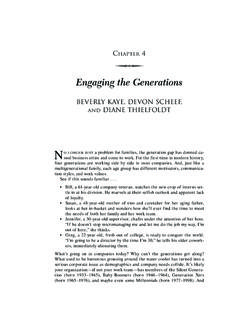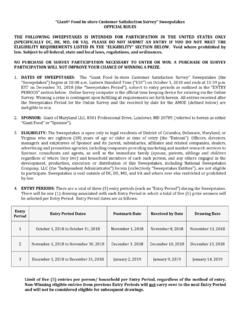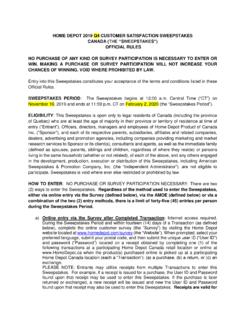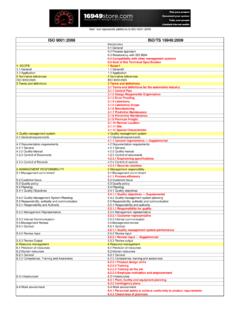Transcription of 07-18-03 Employee Satisfaction Lit Combo
1 CORPORATE LEADERSHIP COUNCIL JULY 2003. KEY FINDINGS. Linking Employee Satisfaction with Productivity, Performance, and customer Satisfaction ESTABLISHING THE LINK: SEMINAL RESEARCH AND OTHER STUDIES. Numerous studies support the idea Research aimed at quantifying the links between Employee Satisfaction and customer Satisfaction , productivity, and financial performance began in 1980 with that there exists a link between 1. Benjamin Schneider's survey of Satisfaction levels of bank customers and employees. Employee Satisfaction and customer Satisfaction , productivity, Studies such as Frederick Reichheld's The Loyalty Effect, (1996) and James Heskett, and financial results.
2 W. Early Sasser, and Leonard Schlesinger's The Service Profit Chain (1997) produced the first sets of hard data quantifying these links. Both studies conclude that there are direct and quantifiable links between customer service variables (such as Satisfaction and loyalty), Employee variables (such as Satisfaction , enthusiasm, loyalty, commitment, 2,3. capability, and internal service quality), and financial results. In 1997, Development Dimensions International (DDI) conducted focus groups, customer interviews, literature reviews, and surveys to determine drivers of an effective service environment.
3 DDI found evidence of a circular relationship between Employee Satisfaction and retention, and customer Satisfaction and loyalty, and increases in company profitability. In addition, Employee Satisfaction was strongly related to Employee commitment and loyalty, and both measures have proven relationships to 4. retention and productivity. It's common sense. When people feel great about the place where In The Service Profit Chain (1997), the authors proposed a model that workforce capability, Satisfaction , and loyalty would lead to customers' perceptions of value. they work they provide better Value perception would lead to customer Satisfaction and loyalty, which would lead to customer service.
4 Profits and growth. The study found that employees' perceptions of their capabilities, 5. Satisfaction , and length-of-service were correlated with customer Satisfaction . -Dick Clark, Group Leader of Financial Services at Monsanto Dr. Thomas Rollins of the Hay Group developed a model linking Employee opinion survey results directly with business performance metrics while excluding customer 6. Satisfaction measures. Main findings include the following: This model holds that company-wide Employee Satisfaction results affect business unit Employee Satisfaction results, which affect business unit financial results, which in turn affect company-wide financial metrics.
5 However, the model also holds that the company-wide financial metrics may also affect company-wide Employee Satisfaction results, allowing the model to demonstrate correlation, but not causation between the different areas considered. ESTABLISHING THE LINK: RECENT STUDIES. Gallup reports that highly satisfied groups of employees often exhibit above-average 7. levels of the following characteristics: customer loyalty (56 percent). Productivity (50 percent). Employee retention (50 percent). Safety records (50 percent). Profitability (33 percent). Research suggests that Employee A Watson Wyatt Worldwide study found that the practice of maintaining a collegial, Satisfaction with the work flexible workplace is associated with the second-largest increase in shareholder value environment correlates positively (nine percent), suggesting that Employee Satisfaction is directly related to financial 8,9,10.
6 Gain. with shareholder value. 2003 Corporate Executive Board CATALOG NUMBER: CLC114T2FH. CORPORATE LEADERSHIP COUNCIL PAGE 2. LINKING Employee Satisfaction WITH PRODUCTIVITY, PERFORMANCE, AND customer Satisfaction KEY FINDINGS. ESTABLISHING THE LINK: RECENT STUDIES (CONTINUED). Over 40 percent of the companies listed in the top 100 of Fortune magazine's America's Best Companies to Work For also appear on the Fortune 500. While it is possible that employees enjoy working at these organizations because they are successful, the Watson Wyatt Worldwide Human Capital Index study suggests that effective human resources practices lead to positive financial outcomes more often than 11,12,13.
7 Positive financial outcomes lead to good practices. The issue of causation did the increases in Employee Satisfaction cause the increase in customer Satisfaction , productivity or profitability, or vice versa is not often addressed in research. However, a 2001 study published in Personnel Psychology examined whether positive Employee behaviors and attitudes influence business outcomes or if the opposite, that positive business outcomes influence Employee behavior, is true. Study 14. findings include the following: The study broke down Employee attitudes and Satisfaction into five measurable Employee behaviors: conscientiousness, altruism, civic virtue, sportsmanship, and courtesy.
8 The study measured participants in the five categories, reviewed turnover rates within the participant population, and compared this data with the organizations' financial performance for the following year. Findings support the idea that Employee Satisfaction , behavior, and turnover predict the following year's profitability, and that these aspects have an even stronger correlation with Employee Satisfaction leads to customer Satisfaction . customer Satisfaction . When internal customers (employees) Price Waterhouse Coopers reported in April of 2002 that 47 percent of surveyed are happy, they treat external executives from multinational companies cite Employee Satisfaction and decreased 15.
9 Customers well. Customers turnover as major contributors to long-term shareholder return. will keep coming back for more. This grows the Other studies indicate that companies found the following from their efforts to study the relationship and leads to links between Employee Satisfaction , customer Satisfaction , productivity, and financial 16,17,18,19,20. performance: customer loyalty.. Unhappy employees are less productive and more likely to have higher absence rates -Richard Federico, Vice President Satisfied employees are more productive, innovative, and loyal and National Work-Life Practice Increases in job Satisfaction lead to increases in Employee morale, which lead to increased Leader at The Segal Company in Employee productivity Survey Links Work-Life Programs Employee Satisfaction leads to customer retention to Employee Performance.
10 CRITICISM OF MODELS LINKING Employee Satisfaction TO PERFORMANCE. While companies with the strongest financial performances often had Employee populations reporting high levels of Employee Satisfaction , companies with poor financial 21. performance also had high levels of Employee Satisfaction . Companies must build their own models because customer Satisfaction is only one variable in understanding the relationship between Employee Satisfaction , customer Satisfaction , and financial performance. Moreover, each company must determine how it defines Employee Satisfaction and customer Satisfaction , which can even differ between 22.








